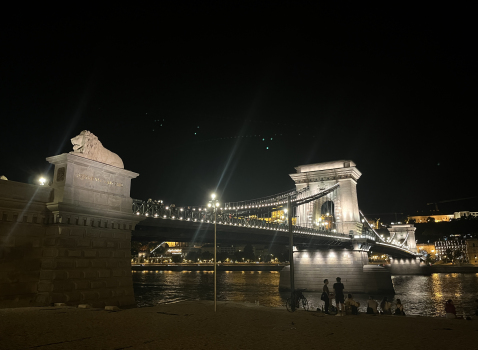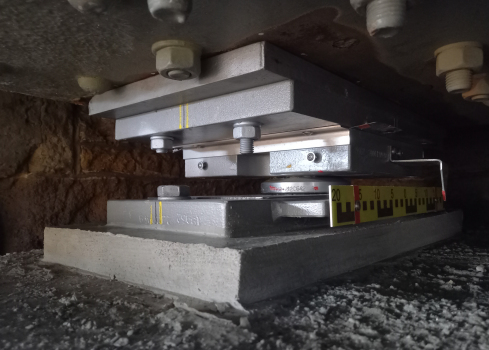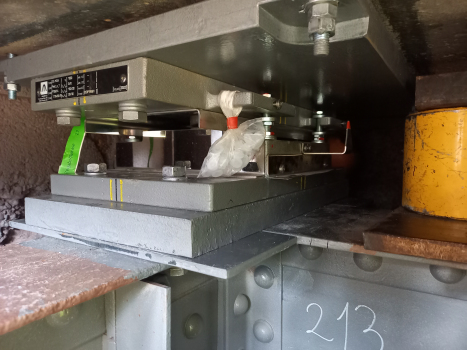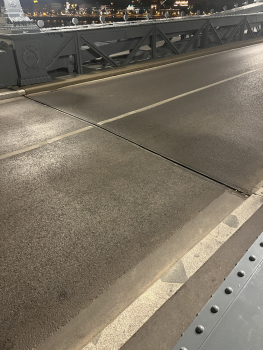Technical Update for the World-Famous Chain Bridge in Budapest
The world-famous Chain Bridge in Budapest was com-pletely renovated – both in terms of its art history and its function. The greatest technical challenge was the bridge bearings. They had to fit into the existing structure and perform special functions, such as protecting against up-lift forces. MAURER developed customised MSM® spheri-cal bearings to this end.
Media
Bearings and expansion joints were tailored towards the historic building fabric
The Chain Bridge over the Danube River in Budapest is a national symbol. Everyone in the country knows the oldest and most famous of the capital’s nine bridges, and all those involved in the extensive renovation were correspondingly sensitive.
The Chain Bridge is almost 15 m wide and 380 m long. The bridge bearings and expansion joints were replaced as part of the steel structures’ renovation and repair as well as the replacement of the reinforced concrete structure of the roadway with an orthotropic steel deck structure. The historic structure posed a number of challenges that had to be taken into account when planning both the bearings and the expansion joints.
Bearing: special case of lifting forces
One of the greatest technical challenges was the bearings. They must be able to move in all directions, compensate for rotations and superimposed loads of up to 1,000 KN. Today, MSM® spherical bearings fulfil all of these requirements – provided the bearings always lie precisely and coherently next to each other in the sliding surfaces.
However, lifting forces regularly occur on the Chain Bridge. These result from the fact that all suspension cables and bridge girders are made of steel and are therefore temperature-sensitive. Since the cables lengthen and shorten, the bridge rises and lowers over the course of the year. And the approximately 1-metre-high loadbearing structure also changes height by several millimetres. The two main steel girders extend into the pylons and rest there on the bearings, albeit in a very special configuration: each support point not only has a bearing below the girder, but also above it. Depending on the load case, the Chain Bridge either rests on the lower bearings or presses against the upper ones.
Specifically, lifting forces occur, for example, when the suspension cables shorten in autumn and the bridge rises. If a bus then crosses the bridge, very rapid load changes occur between applied and immediately lifting forces. These constant and frequent load changes lead to wear in normal bearings. In order to ensure that the bearing components are in a compressed state in every load case at all times, and especially when lifting forces occur, they were equipped with special springs and guide systems, which prevents wear. "Calculating the number and effects of bus crossings on the service life of the bearing components proved to be a major challenge," reports MAURER Project Manager Csaba Simon. The precise specification of the bearings was developed in close coordination between the General Contractor and MAURER.
Installation: tightness and unevenness
The installation of the bearings between July and September 2022 posed two further challenges: the support points and the connection to the old structure.
The support points in the pylon were difficult to access and there was very limited space. Only fitters of smaller height were able to work there at all. What is more, the old connecting steel structures were uneven. However, to ensure optimum load transfer from the bridge girders to the new bearings an absolutely frictional connection is required. The unevenness was levelled out with a special filler, a so-called cold "multi-metal".
MAURER supplied a total of 32 MSM®/MSA® spherical bearings with devices against lifting forces. The modern sliding material MSM® (MAURER Sliding Material) can absorb extremely high pressure, which is why the bearings could be built small. The MSA® sliding alloy is corrosion-resistant and extremely wear-resistant.
The upper and lower bearings differ only in size, but not with respect to their technical specification. They are up to 640 x 300 mm in size, weigh up to 113 kg and can accommodate a load of up to 1,000 KN. They can slide up to 150 mm in the longitudinal and 200 mm in the transverse direction, and rotate by 30 mrad in all directions.
Expansion joints: adapted geometry
The new expansion joints on the historic Chain Bridge were also supplied by MAURER, not least because the company is renowned in Hungary for its quality and technical expertise. For example, MAURER has supplied the largest expansion joints in the country with movements of up to 1,400 mm. In the case of the Chain Bridge, the main task was to adapt the expansion joints to the complex geometry of its historic structure.
Four MAURER DT160 HYBRID expansion joints were installed on the pylons and two MAURER D100 HYBRID expansion joints on the abutments. "DT" means that compression-shear-springs can accommodate scheduled movements deviating from the main direction of movement, which made guides for the bearings unnecessary. "Hybrid" refers to the material: the upper parts of the profiles including retaining claws are made of stainless steel, and so the expansion joint is protected against corrosion in the areas that come into contact with traffic and moisture. The expansion joints extend across the entire width of the bridge and weigh up to 2.6 tonnes.
"On the whole, a further challenge was to coordinate all the historical features, which cannot be compared with a modern new building, and the resulting complex consequences with all parties involved: from monument protection to construction and production to installation," reports Csaba Simon. "It is important to remember that most of those involved communicated in a foreign language: at MAURER, English was the in-house project language, while Hungarian and German were often spoken, too."
The Client of the was the BKK Zrt. (BKK Centre for Budapest Transport) and the General Contractor was A-HÍD Zrt. The renovated Chain Bridge was inaugurated in August 2023.
References
Structure Types
- About this
data sheet - Product-ID
8047 - Published on:
05/02/2024 - Last updated on:
05/02/2024






 MAURER SE
MAURER SE 
